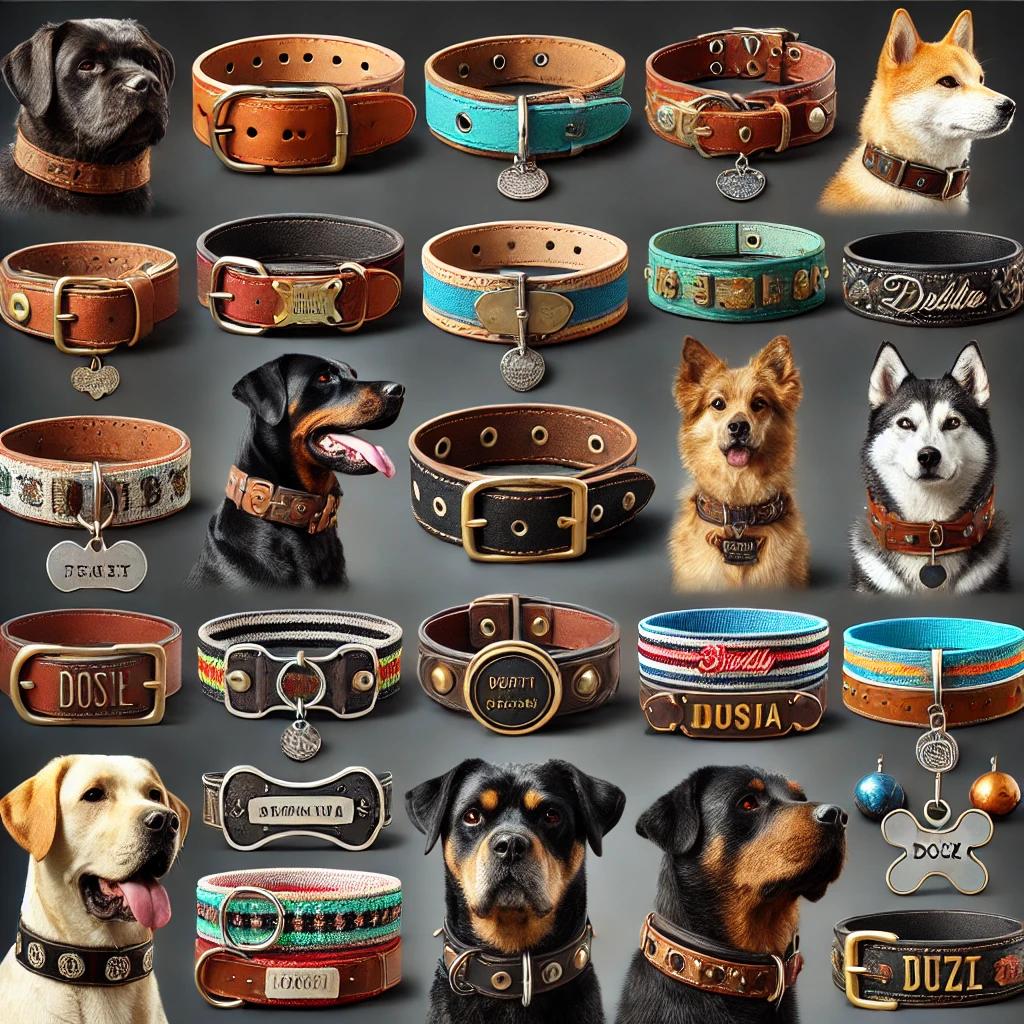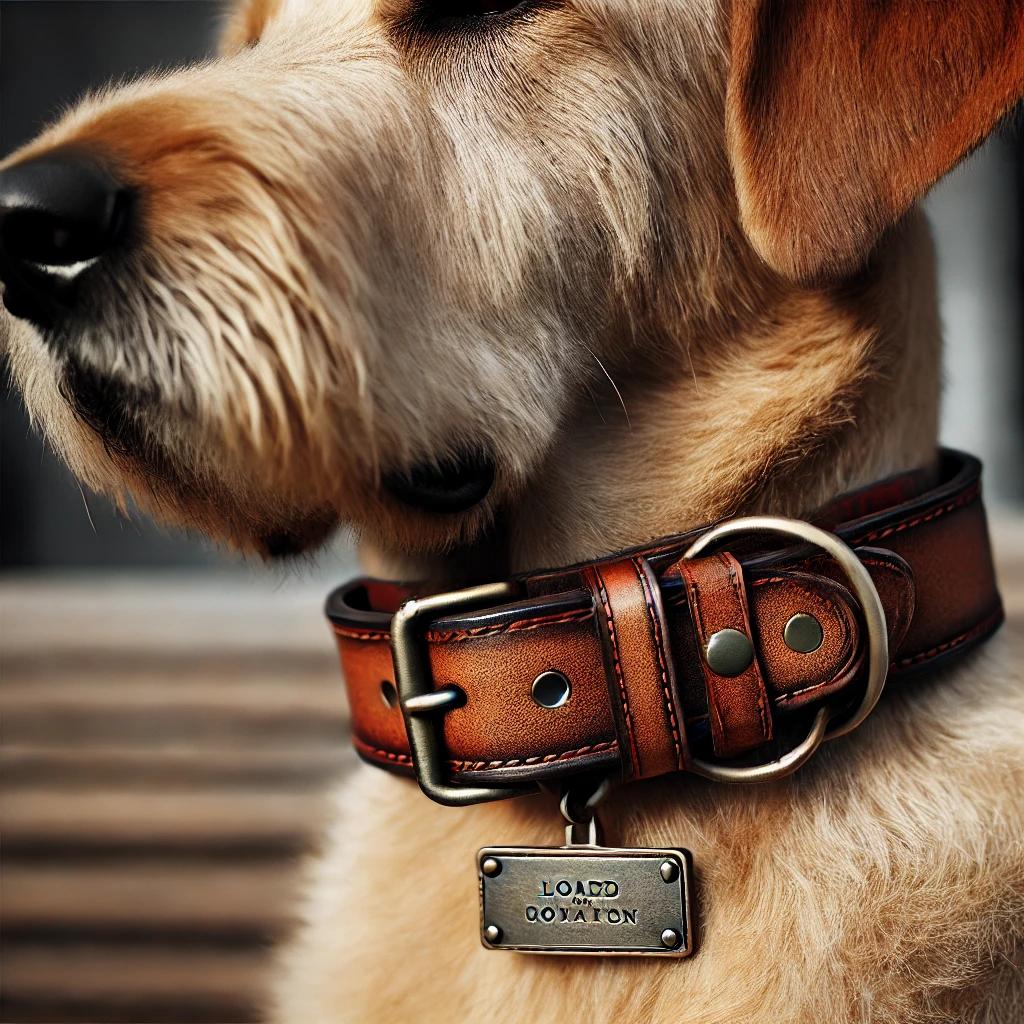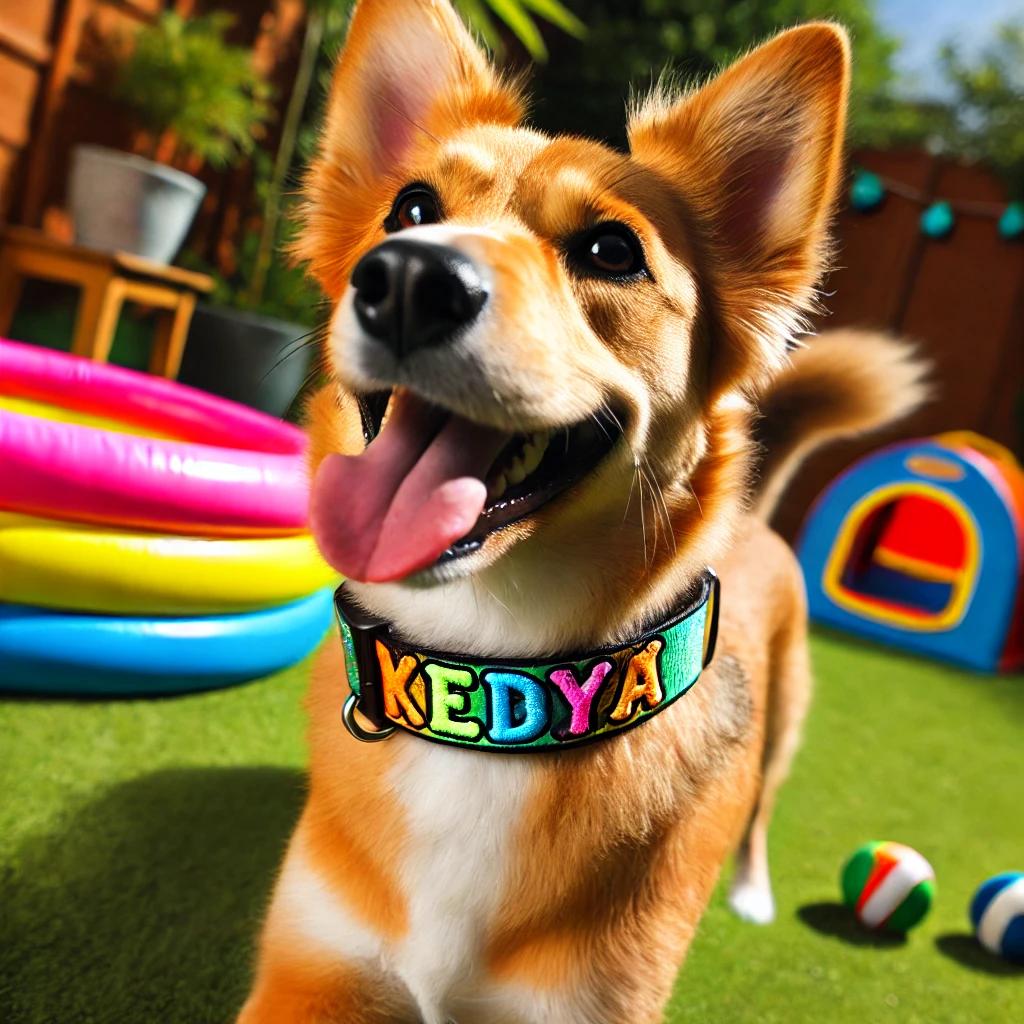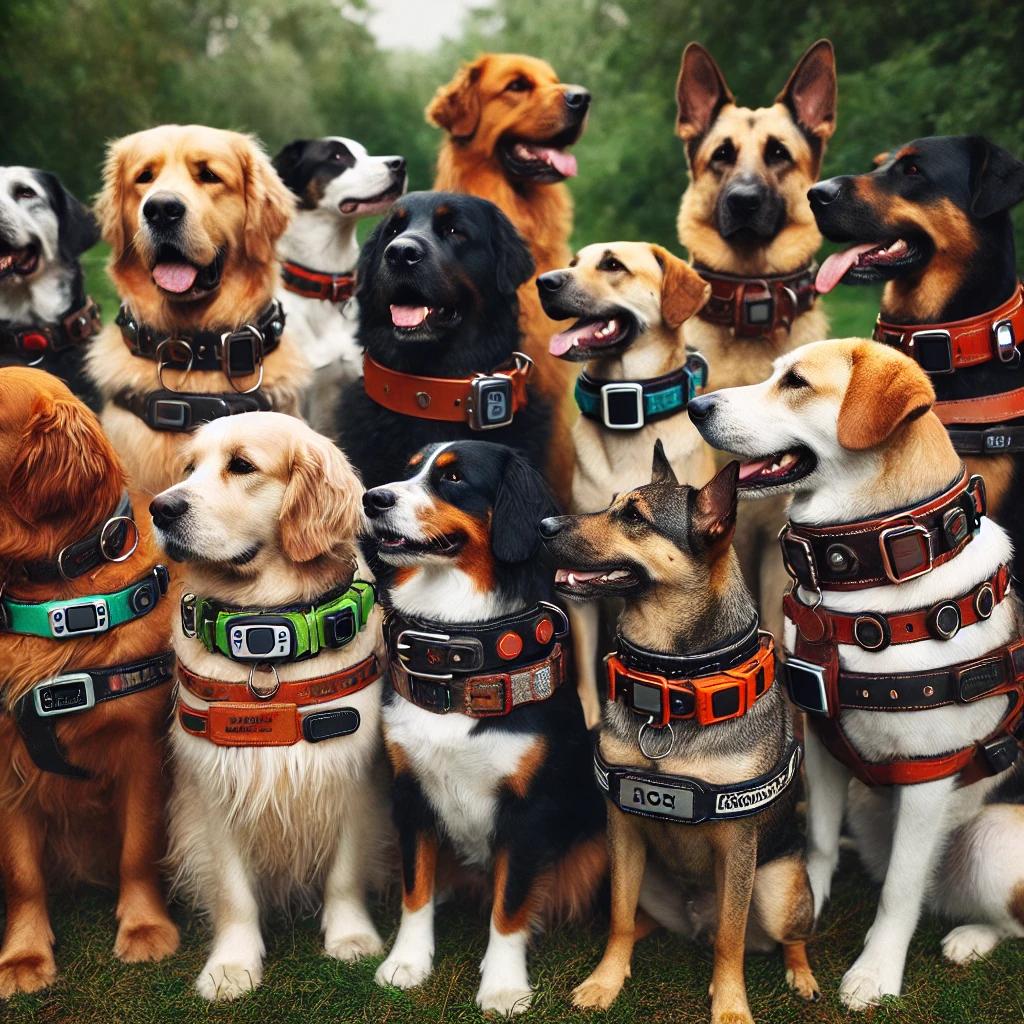
Dog collars are more than just a functional accessory for your pet; they are a vital tool in training, identification, safety, and even style. From the traditional leather dog collars to custom dog collars, the options can seem endless, which is why it’s important to choose the right one for your furry friend. This comprehensive guide will take you through everything you need to know about dog collars, their types, functions, and why investing in the right collar is crucial for your dog’s well-being.
Table of Contents
- What is a Dog Collar?
- The History and Evolution of Dog Collars
- Types of Dog Collars
- Flat Collars
- Martingale Collars
- Leather Dog Collars
- Personalized Dog Collars
- Custom Dog Collars
- How to Choose the Right Dog Collar
- Leather Dog Collars: Timeless, Durable, and Stylish
- Personalized and Custom Dog Collars: Why Go the Extra Mile?
- Common Materials Used in Dog Collars
- The Role of Dog Collars in Training
- Dog and Collars: A Lifelong Bond
- Safety Considerations When Using Dog Collars
- Data and Trends in Dog Collars
- Caring for Your Dog Collar: Maintenance Tips
- Conclusion: Dog Collars as a Reflection of Your Dog’s Personality
1. What is a Dog Collar?
A dog collar is a simple but essential tool used by millions of dog owners worldwide. It is typically a strap made of leather, fabric, or another durable material that fastens around a dog’s neck. But a dog collar is much more than a band of material—it serves a variety of crucial functions in your dog’s daily life.
Functionality of Dog Collars
- Identification: Most dog collars have a place where you can attach ID tags, including the dog’s name, the owner’s contact information, and proof of rabies vaccination.
- Leash Attachment: The collar provides a safe and secure place to attach a leash, making it essential for walking and controlling your dog in public spaces.
- Training Aid: Collars are also used in training dogs, particularly when teaching them to heel, sit, stay, or walk without pulling on the leash.
- Behavioral Management: Certain types of collars are designed to discourage unwanted behaviors, such as pulling or lunging.
2. The History and Evolution of Dog Collars
The use of dog collars dates back thousands of years. Ancient Egyptians and Mesopotamians used leather dog collars to signify a dog’s status and role within society. These collars were often adorned with intricate designs and were a symbol of wealth and power.
In ancient Greece and Rome, dogs were used for protection and hunting, and their collars evolved into functional pieces designed for defense. Large spiked collars were used to protect hunting and guard dogs from wild animal attacks, a design that persists today in decorative spiked collars.
In medieval Europe, collars became even more symbolic. Royals would decorate their dogs with ornate, jeweled collars to display their status. By the time we reached the Victorian era, dog collars started to resemble the more practical and decorative designs we see today.
The modern dog collar has continued to evolve, with innovations in safety, design, and technology. From traditional leather dog collars to high-tech GPS-enabled collars, dog owners today have more options than ever before.
3. Types of Dog Collars
With so many types of dog collars available, choosing the right one can be overwhelming. Each type of collar serves a unique purpose, and understanding these purposes will help you make the best choice for your dog.
Flat Collars
Flat collars are the most common type of dog collar, often made from materials like nylon, polyester, or leather. These collars are designed for general use and are often equipped with a buckle or a snap closure. They are ideal for daily wear and attaching ID tags.
- Best for: Everyday use, dogs who don’t pull excessively.
- Pros: Simple, durable, and available in a wide variety of colors and designs.
- Cons: Not ideal for dogs who pull on the leash as it offers little control.
Martingale Collars
Martingale collars are designed to tighten slightly when the dog pulls, which prevents the dog from slipping out of the collar but without choking them. These collars are ideal for dogs with narrower heads, like Greyhounds, who can easily slip out of regular flat collars.
- Best for: Dogs that are escape artists or have narrow heads.
- Pros: Provides more control without being too harsh.
- Cons: Must be adjusted properly to avoid discomfort.
Leather Dog Collars
One of the most classic and durable choices, leather dog collars are known for their longevity and stylish appeal. These collars are especially popular among dog owners who want a timeless, sophisticated look for their pets. Leather is also known to soften over time, making it more comfortable for the dog.

- Best for: Dog owners looking for durability and style.
- Pros: Long-lasting, comfortable, and ages beautifully.
- Cons: Requires maintenance (cleaning and conditioning) and can be more expensive than other materials.
Personalized Dog Collars
Personalized dog collars allow owners to customize the collar with their dog’s name, contact details, or other identifying information. These collars can be embroidered, engraved, or even printed, making them a great safety feature in case your dog gets lost.
- Best for: Dogs who may wander or get lost, providing immediate identification.
- Pros: Added security, stylish, easy to personalize.
- Cons: Some personalized features, like metal plates, may add extra weight.
Custom Dog Collars
Custom dog collars take personalization a step further by allowing owners to design a collar that suits their dog’s unique needs. From padding for comfort to additional safety features like reflective materials or built-in GPS trackers, custom collars can be as simple or high-tech as you wish.
- Best for: Dog owners with specific needs or those who want their dog to stand out.
- Pros: Fully tailored to your dog, with features like waterproof materials, extra padding, or high-tech functions.
- Cons: Custom designs can be more expensive and may take longer to produce.
4. How to Choose the Right Dog Collar
Choosing the right collar involves balancing aesthetics, functionality, and your dog’s specific needs. A collar that is too tight can cause discomfort or injury, while one that is too loose can slip off.
Key Considerations:
- Dog’s Size and Weight: Heavier dogs need collars made from sturdier materials like leather or reinforced nylon. Smaller dogs, on the other hand, may be more comfortable with lightweight materials.
- Material: Leather is stylish and durable, while nylon is more affordable and comes in a wider variety of designs.
- Adjustability: Ensure the collar is adjustable so that it can grow with your dog if needed.
- Special Features: Consider personalized dog collars with your contact information or custom dog collars with built-in safety features like reflective strips for nighttime walks.
5. Leather Dog Collars: Timeless, Durable, and Stylish
Leather dog collars remain one of the most popular choices among dog owners for their durability and stylish appearance. While they may require more care than synthetic collars, the benefits of a leather collar often outweigh the maintenance involved.
Advantages of Leather Dog Collars
- Durability: Leather is incredibly tough, and with proper care, it can last for years.
- Comfort: Over time, leather becomes more supple and soft, reducing the risk of chafing.
- Classic Look: Leather collars offer a timeless, classic look that never goes out of style. They are often available in various colors and can include decorative stitching, studs, or embossing.
Disadvantages:
- Price: Leather collars tend to be more expensive than nylon or polyester collars, but they make up for it with longevity.
- Care: Leather requires regular cleaning and conditioning to prevent drying and cracking, especially if it gets wet frequently.
6. Personalized and Custom Dog Collars: Why Go the Extra Mile?
Investing in a personalized dog collar or custom dog collar is more than just about appearance; it can also play a vital role in your dog’s safety and well-being.

Why Choose a Personalized Dog Collar?
Imagine your dog runs away, and someone finds them. The first thing they’ll notice is the collar. If your dog’s collar is personalized with their name and your contact information, you’re much more likely to be reunited quickly. Many dog owners also personalize their collars to include medical information, such as allergies or health conditions, which can be crucial in an emergency.
The Benefits of Custom Dog Collars
- Perfect Fit: Custom collars can be made to perfectly fit your dog’s neck size, avoiding any discomfort or safety risks.
- Unique Features: You can add extra features, such as GPS tracking, reflective materials, or even waterproof designs, making the collar as functional as possible.
- Style: Whether you want something chic, playful, or rugged, custom collars allow you to tailor the design to your dog’s personality.
7. Common Materials Used in Dog Collars
Each material used for dog collars has its own set of pros and cons. Understanding these can help you select the right material based on your dog’s lifestyle and needs.
- Nylon: This is the most common material for dog collars due to its affordability, durability, and ease of cleaning. It comes in a wide variety of colors and patterns, making it a versatile option for many dog owners.
- Leather: Known for its durability and classic style, leather is a popular choice for those looking for a long-lasting collar. However, leather collars require more maintenance to keep them in good condition.
- Neoprene: This material is lightweight, waterproof, and padded for extra comfort, making it ideal for dogs that spend a lot of time in the water.
- Biothane: Biothane is a newer material that offers the strength of leather but with waterproof capabilities. It is often used for hunting dogs or dogs that frequent wet environments.
8. The Role of Dog Collars in Training
Dog collars are an essential tool in training, especially for young puppies and newly adopted dogs. Different collars serve various purposes in the training process.
Training Collar Options
- Flat Collars: Suitable for basic training like teaching your dog to walk on a leash.
- Martingale Collars: These collars provide gentle correction without choking, which makes them ideal for training dogs that tend to pull or try to escape.
- Choke Chains: While effective for behavior correction, choke chains should be used cautiously and under supervision to prevent injury.
- Prong Collars: Designed for aggressive pullers, prong collars should only be used as a last resort and under the guidance of a professional trainer.
- Electronic Collars: Often used for advanced training, electronic collars deliver a small shock or vibration to reinforce commands. These are controversial and should only be used with proper training and understanding.
9. Dog and Collars: A Lifelong Bond
The bond between a dog and its collar is significant. Your dog’s collar will be with them through daily walks, playtime, and adventures. From the moment you place a collar around your puppy’s neck, it becomes a constant part of their life, representing both safety and belonging.
Your choice of collar says as much about your dog’s personality as it does about you as an owner. Some dogs will wear brightly colored, whimsical collars, while others will sport rugged leather collars with brass fittings.
Symbol of Care
A well-chosen collar represents the love, attention, and care you give your dog. It’s a simple object, but it holds powerful meaning. Whether you choose a personalized dog collar with your dog’s name embroidered on it or a classic leather collar that will last for years, that choice reflects the bond you share with your pet.
10. Safety Considerations When Using Dog Collars
While dog collars are generally safe, there are a few safety concerns that every dog owner should keep in mind.
- Proper Fit: A collar that is too tight can cause choking or neck injuries, while a collar that is too loose may slip off, leaving your dog vulnerable.
- Material Sensitivities: Some dogs are allergic to certain materials. Be sure to monitor your dog for any signs of irritation, redness, or discomfort when they first start wearing a new collar.
- Breakaway Collars: For dogs that spend time outdoors or around other animals, consider using a breakaway collar. These collars are designed to release under pressure, which can prevent choking accidents if the collar gets caught on something.
- Reflective Materials: If you walk your dog at night or in low-light conditions, a collar with reflective material is an excellent safety feature that increases your dog’s visibility to drivers and other pedestrians.
11. Data and Trends in Dog Collars
The dog collar industry has seen remarkable growth in recent years, driven by both practical needs and the rise in pet fashion. The global pet accessories market is projected to exceed $15 billion by 2025, with dog collars accounting for a significant portion of that growth.
Leather Dog Collars: A Popular Choice
Leather dog collars remain a favorite among dog owners, with approximately 30% of dog owners opting for leather over synthetic materials. This can be attributed to leather’s durability, classic style, and the premium feel it offers.
Personalized Dog Collars: Growing Demand
The demand for personalized dog collars has seen a sharp rise, particularly in urban areas where dog owners are keen to ensure that their pets are easily identifiable. With the increasing number of dogs being adopted from shelters, personalized collars offer an added layer of security in case the dog gets lost.
High-Tech Dog Collars
The market for high-tech dog collars, including those with built-in GPS trackers, is also expanding. These collars provide real-time tracking, allowing owners to monitor their dog’s location and activity levels. This is particularly useful for owners of large properties or those who take their dogs hiking or on other outdoor adventures.
12. Caring for Your Dog Collar: Maintenance Tips
Regardless of the material, dog collars require regular care and maintenance to keep them in good shape.
Leather Collars
Leather dog collars need to be cleaned with a damp cloth and occasionally treated with a leather conditioner to keep them supple. Avoid soaking leather collars in water, as this can cause the leather to crack or warp over time. If your dog’s leather collar gets wet, let it air dry away from direct sunlight to avoid shrinking or drying out.
Nylon and Fabric Collars
Nylon and fabric collars are more low-maintenance but should still be cleaned regularly, especially if your dog swims often or gets muddy during walks. You can hand-wash these collars in mild soap and water, or even toss them in the washing machine on a gentle cycle. Be sure to inspect the collar for any signs of wear, such as fraying or weakened stitching.
Metal Components
If your dog’s collar has metal components, such as buckles or ID tags, it’s a good idea to check them regularly for rust or signs of wear. Clean them with a soft cloth and mild soap, and replace any damaged hardware to ensure your dog’s collar remains safe and functional.
13. Conclusion: Dog Collars as a Reflection of Your Dog’s Personality

From leather dog collars to custom dog collars, the options for your furry friend are endless. A collar is more than just a tool; it’s an expression of your dog’s personality, your style, and your commitment to their well-being. Choosing the right collar can enhance your dog’s comfort, safety, and happiness, making it an essential part of your dog’s everyday life. So, whether you opt for a personalized dog collar with their name proudly displayed or a rugged leather option, your choice of collar will serve as both a functional tool and a meaningful symbol of the special bond you share with your pet.
External Resources:
PetMD – Dog Collar Types – An overview of different types of dog collars and their purposes.
American Kennel Club – Choosing a Collar – Helpful tips on selecting the right collar and leash for your dog.
The Spruce Pets – Best Dog Collars – Recommendations for the best dog collars available today.
Related Posts:
The Ultimate Guide in 2024 to Gun Dog Training: Skills, Supplies, and Tips for Success
Master the art of training your gun dog with essential skills and expert tips tailored for success in the field.
Learn More
Bubble Theory Dog Training: A New Approach
Explore innovative training techniques with the Bubble Theory, designed to improve communication with your dog.
Learn More
Effective Training Dog Collars for Obedient Pets in 2024
Discover the best training collars available this year to help you achieve a well-behaved and obedient pet.
Learn More
The Ultimate Guide to Dog Toilet Training Grass: Everything You Need to Know
Learn how to effectively use dog toilet training grass for a hassle-free potty training experience.
Learn More
The Ultimate Guide to Dog Backpacks: Practical and Fun Solutions for Adventurous Dogs
Equip your dog for adventures with the best dog backpacks designed for comfort and utility.
Learn More
The Ultimate Guide to Dog Fences: Everything You Need to Know
Discover your options for dog fencing to keep your furry friend safe and secure at home.
Learn More
The Ultimate Guide to Dog Harnesses: Everything You Need to Know
Explore the benefits of different harness types and how to choose the right one for your dog.
Learn More
Thank you for reading Dog Collars: Everything You Need to Know, What do you love most about this blog?
Share your thoughts in the comments below! If you enjoyed this post, consider subscribing to our newsletter for more pet tips, stories and blogs!
